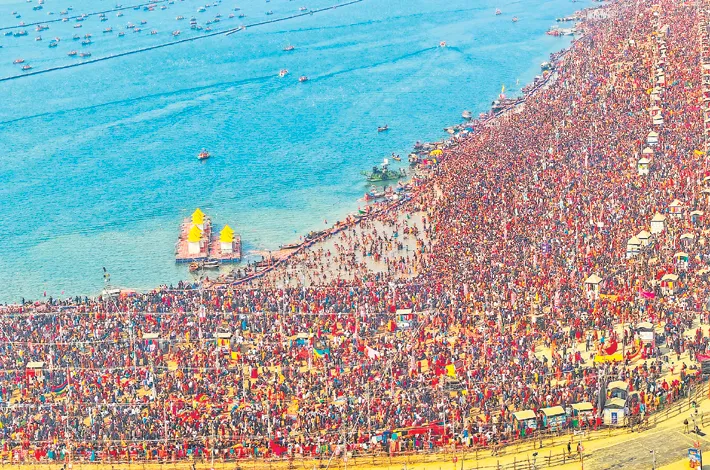Maha Kumbh: The Sacred Confluence Uniting Hindus
28-02-2025 12:05:54 AM

As twilight descended on February 26, 2025, the sacred Triveni Sangam in Prayagraj shimmered under a molten amber sky, its waters rippling with the reflections of a million flickering oil lamps. The Maha Kumbh Mela 2025, a 45-day symphony of devotion from January 13 to February 26, reached its crescendo and drew to a close, leaving an indelible mark on the soul of India.
Uttar Pradesh Chief Minister Yogi Adityanath announced that a staggering 66.21 crore (662.1 million) pilgrims had plunged into the icy embrace of the Ganga, Yamuna, and mythical Saraswati rivers, a record that dwarfed all past gatherings and crowned this event as the grandest congregation in human history.
Dictated by the rare alignment of celestial bodies—Jupiter in Taurus, the sun in Capricorn, and a new moon—this Maha Kumbh was a kaleidoscope of faith, color, and unity. The sprawling sandy banks of the Sangam swelled with humanity, their chants of Har Har Mahadev reverberating across the misty air, as devotees from every corner of India and beyond converged in a mesmerizing pilgrimage that defied caste, region, and language.
A Torrent of Faith: The Sacred Dip That Bound Millions
The scale was nothing short of biblical. On the opening day of Paush Purnima, January 13, the riverbanks trembled under the weight of 1.5 crore devotees, their bare feet crunching the frost-kissed sand as they waded into the bone-chilling waters, steam rising from their breath in the dawn fog. The zenith arrived on January 29, Mauni Amavasya, when over 10 crore souls stormed the ghats for the third Shahi Snan, their silhouettes blending into a heaving sea of saffron and white against the pewter-gray river. By the festival’s end, marked by Maha Shivratri, 66.21 crore had taken the plunge, their collective fervor captured by 3,700 AI-enabled cameras that tracked this tidal wave of devotion.
Here, distinctions melted like wax in a flame. A Dalit farmer from Tamil Nadu bathed beside a Brahmin scholar from Varanasi; a Marathi trader shared a smile with a Bihari ascetic. The Maha Kumbh wove a vibrant thread through India’s diverse fabric, uniting pilgrims in a singular pursuit of moksha—liberation from life’s endless cycle. Defence Minister Rajnath Singh, emerging from his dip, his dhoti dripping with sacred water, captured it poetically: “The Sangam washes away all differences, leaving only the purity of oneness.”
The Naga Sadhus: Enigmatic Warriors of the Spirit
Amid the throngs, the Naga Sadhus stole the spotlight—wild, ash-dusted ascetics with matted dreadlocks cascading like tendrils of smoke, their piercing eyes glinting with otherworldly zeal. Clad only in the sky, wielding tridents and swords, these mystics of the Juna and Niranjani akharas stormed the ghats during the Shahi Snans, their arrival heralded by conch shells and the thunder of hooves as they rode chariots, elephants, and stallions draped in marigold garlands. Their bodies, smeared with vibhuti from cremation grounds, shimmered in the sunlight, a living testament to their renunciation of worldly ties.
In Sector 21’s tent city, 800 novices joined their ranks, their heads shaved under a banyan tree as saffron-robed gurus chanted mantras, the air thick with incense and the crackle of ritual fires.
Foreigners, like a 90-member Argentine delegation and Laurene Powell Jobs, stood transfixed, cameras clicking furiously as these “holy warriors” bathed first, their roars blessing the waters with divine potency. A French journalist, Milani, scribbled in awe: “They are like living myths, untamed and eternal.”
Prayagraj: A Living Canvas of Divinity
Prayagraj itself became a vision of ethereal beauty. The Triveni Sangam, where the Ganga’s muddy torrent kisses the Yamuna’s emerald flow, gleamed like a liquid jewel, its banks adorned with 12 km of ghats draped in saffron flags that fluttered like a thousand tiny prayers. The 4,000-hectare tent city sprawled like a nomadic kingdom, its 1.5 lakh tents glowing under strings of fairy lights, while 145,000 gleaming toilets lined the labyrinthine 450 km of roads. Murals of Rama’s exile and Krishna’s leela danced across walls, their colors vivid against the dawn mist.
Helicopters rained rose petals that fluttered down like fragrant snow, and a water laser show painted the night with iridescent beams, casting scenes of Shiva’s tandava over the river. The air buzzed with the hum of underwater drones and the chatter of AI chatbots guiding pilgrims in 11 tongues. A Nepali devotee, Niranjan Mishra, his face streaked with sandalwood paste, marveled at the “city born overnight,” while Crystal from Belgium, wrapped in a borrowed shawl, gushed over the “symphony of chaos and calm.”
Unity in Diversity, Prosperity in Faith
The Maha Kumbh was a crucible of unity. Sadhus with dreadlocks swaying like serpents shared prasad with villagers in tattered lungis; urban yogis in branded kurtas bowed alongside tribal women adorned with turmeric-stained threads. ISKCON’s steaming vats fed one lakh daily, while the Adani Group’s langars brimmed with dal and rice, their aromas mingling with the scent of camphor and cow dung fires. A Khadi exhibition showcased weavers from Gujarat to Manipur, their looms clacking in rhythm with the pilgrims’ chants.
Economically, the festival roared like a juggernaut, injecting ₹2 trillion into India’s veins, as per the Confederation of All India Traders. Luxury tents by ITDC gleamed beside hawkers’ stalls peddling rudraksha beads, a testament to the Maha Kumbh’s dual pulse of spirituality and commerce.
A Farewell in Flames and Flowers
As the final day waned, the ghats blazed with a million diyas, their flames dancing on the water like stars fallen to earth. Bhajans swelled, then softened, leaving a hush as pilgrims departed, their wet clothes clinging like sacred relics. The Maha Kumbh 2025 closed not as an end, but as a promise—a radiant chapter of faith, unity, and renewal, its echoes destined to ripple through time for the next 144 years.
- Key data
- Event Duration: 45 days (Jan13, 2025 – Feb 26, 2025)
- Location: Triveni Sangam, Prayagraj, Uttar Pradesh, India
- Total Devotees: 66.21crore 662.1 million) took the holydip by February 26,
- Peak Day (Mauni Amavasya): Over 10 crore(100 million bathed on January 29, 2025
- First Day (Paush Purnima): 1.5 crore (15 million) bathed on January 13, 2025
- Mid-Point Milestone: Over 50 crore (500 million) bathed by mid-February 2025
- Final Day (Maha Shivratri): Over 11.66 lakh (1.166 million) bathed by 2 AM on February 26, 2025
- Area Covered: 4,000 hectares (40 km²) temporarytent
- Ghats Length: 12 km (7.5 miles) of riverbanks forbathing








